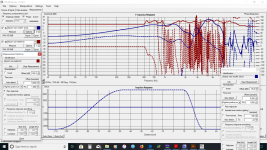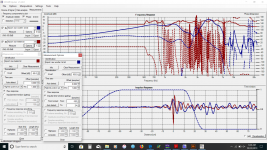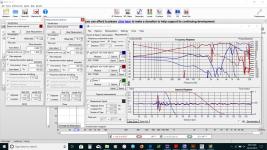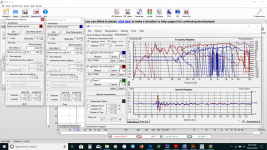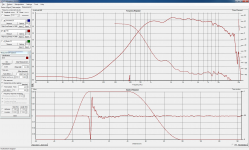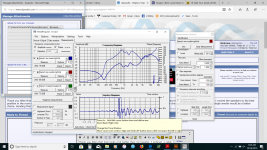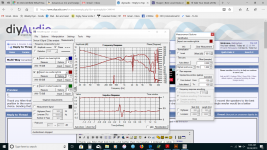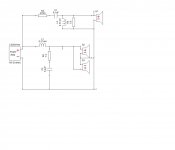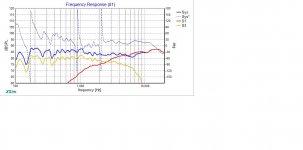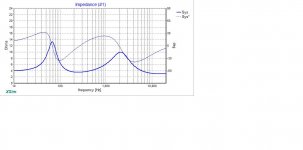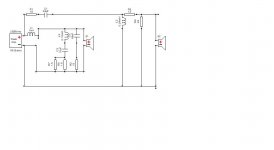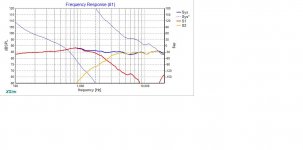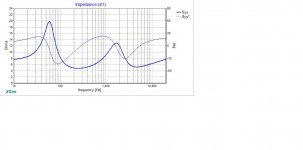Holm will measure phase including delay, accurately with a one channel measurement. This way you can use the results directly, and decide while simming whether to go with different slopes or actual delay.
Do not change the woofer delay in your sim. It is already included in the measurements and you'll double up. (Erik, I think the woofer delay setting is better used with simmed baffles.)
The two things to set after a measurement are the start point and the end point. If you set each measurement to the same start point, the delay will be correctly included. This can be done in the lower impulse plot, or in the measurement options beside each measurement set on the left. (There is an auto time lock in the middle tab, but for some reason I don't like using it.) Set the time at the beginning of the earliest arriving driver .
.
The gating time should be just long enough to get the lowest frequencies you need but if you need to cross into a reflection (you can see them on the impulse), you'll compromise higher frequencies.
Do not change the woofer delay in your sim. It is already included in the measurements and you'll double up. (Erik, I think the woofer delay setting is better used with simmed baffles.)
The two things to set after a measurement are the start point and the end point. If you set each measurement to the same start point, the delay will be correctly included. This can be done in the lower impulse plot, or in the measurement options beside each measurement set on the left. (There is an auto time lock in the middle tab, but for some reason I don't like using it.) Set the time at the beginning of the earliest arriving driver
The gating time should be just long enough to get the lowest frequencies you need but if you need to cross into a reflection (you can see them on the impulse), you'll compromise higher frequencies.
HI thank you
I have an old MacBook I am using as a music server and as a soundcard since it has separate mic and toslink output it works well for the measurements. I will have to figure out how to use my windows computer with the mic and output on the same jack. after reading I will first try to import the rew data. may be quicker.
with using the mtm baffle will the second woof even thou it is disconnected will it kind of work as a passive radiator and mess up the readings?
when measuring the tweeter should I start at the resonate frequency to avoid tweeter damage say 500hz?
Sorry for all of the questions. The book I am reading has a lot of information but does not really cover these issues. also how do you decide what style of crossover to use which order and which style and series or parallel. Mr Weems does a good job of explaining the crossover and the math to choose components but I really don't get how to make the choice of which crossover. thanks again
I have an old MacBook I am using as a music server and as a soundcard since it has separate mic and toslink output it works well for the measurements. I will have to figure out how to use my windows computer with the mic and output on the same jack. after reading I will first try to import the rew data. may be quicker.
with using the mtm baffle will the second woof even thou it is disconnected will it kind of work as a passive radiator and mess up the readings?
when measuring the tweeter should I start at the resonate frequency to avoid tweeter damage say 500hz?
Sorry for all of the questions. The book I am reading has a lot of information but does not really cover these issues. also how do you decide what style of crossover to use which order and which style and series or parallel. Mr Weems does a good job of explaining the crossover and the math to choose components but I really don't get how to make the choice of which crossover. thanks again
Last edited:
I'd be interested in what Erik has to say here as I haven't used a dome designed in recent years. I've always found them to handle a 20Hz sweep at good volumes but am reluctant to recommend it.8ntractor said:when measuring the tweeter should I start at the resonate frequency to avoid tweeter damage say 500hz?
Is there a reason you can't use one output channel from a stereo output and one input from a stereo input?the mic and output on the same jack.
IntelHDA will do jack retasking if you have anything unusual you want to do.
Since both are meant to play together over the same band, why not measure them together? Even if doing full angular measurements it would be best to have them together. Unless maybe you plan to do a half measured, half simmed crossover.with using the mtm baffle will the second woof even thou it is disconnected will it kind of work as a passive radiator and mess up the readings?
The order, the slope will hopefully be gradual but in reality design constraints tend to push things tighter. I reckon that when you give it enough thought, set your priorities and learn about your drivers, you'll begin to settle on a crossover frequency.how do you decide what style of crossover to use which order and which style and series or parallel.
Say then you find that there is a woofer breakup mode at some frequency and you want things to be down by some level of dB at that point, now you have your slope decided. The tweeter could also be the limiter.
You could get the same result with a series or parallel crossover if you try. However I would stay with parallel for now, unless you are planning to get the best results you can with fewer components?
thank you Allen
I think the reason for measuring one driver is how you enter it in sim. as two individual drivers at least that was my thinking. Is there an issue with measuring in REW and transfering the data to Holm and the gating ? I tried it and it seems to work ok.
thank you I will go parallel I use bi wire so I think parallel may be better for that also.
I think the reason for measuring one driver is how you enter it in sim. as two individual drivers at least that was my thinking. Is there an issue with measuring in REW and transfering the data to Holm and the gating ? I tried it and it seems to work ok.
thank you I will go parallel I use bi wire so I think parallel may be better for that also.
It depends how you do it. If you transfer a frequency response plot, the delayed energy including speaker diffraction will not have its delay registered. You would need to transfer an impulse response. However, it can't be an impulse that was constructed from the frequency response either. The thing with Holm is that it knows the signal it put out, and specifically waits for its return so it knows which parts of the incoming signal are direct and which are delayed.Is there an issue with measuring in REW and transfering the data to Holm and the gating ?
Regarding bi-wire, yes use parallel.
Sims tend to cater for two types. Those that want to measure everything and sim the crossover, and those that start with manufacturer response plots and want to sim the whole speaker around it. (Of the first type, there are those that use single plots per driver and those that use many.) .. This is why these options exist.I think the reason for measuring one driver is how you enter it in sim.
every movement changes the FR. Reading Weems he builds a 6 ft round baffle. this may sound crazy but I am not sure of what I am shooting for I know I want an FR to match the one posted slight rolloff to the high end. I think I know that the impedance should be smooth with a small hump in the bass and a small hump at the crossover and stay above 4ohms. Is there more that I am missing.
Hi Allen Here is a screen shot I hope I got the info you are looking for thank you. I did switch the speakers right for left and the large dip in the bass on the left speaker is the room. thank you again for your help
Attachments
Last edited:
Ok, ...
In the measurement options for the tweeter, below 'raw response', choose 'Impulse time-window (gating)'. This explains why moving around the room makes a difference when it shouldn't.
In the impulse response window, you can only see a flat plot. The vertical is zoomed out. Maybe you could click on auto zoom, then zoom out as required and reverse drag across the plot to zoom back in.
The blue arrow just before 2kHz indicates the lowest frequency that your gating window can resolve, which of course you can change. First though, the start point is -100 (from locked) which includes some empty space, which is counted, so you aren't even actually quite getting 2kHz. You might be able to set it to -20, watch that this doesn't affect the measurement by chopping off the start (make sure the response stays close to the same and that both channels are done. Then you can extend the time by either dragging the right side of the dashed line on the impulse plot or setting in the 'To:' box next to 'auto detect'.
It may or may not be an issue that your measurement came in at over 0dB. Noise gets further away, but distortion gets closer. (Just noticed your offset, ouch, unless something isn't calibrated. Not important though as long as you are within a good operating region.)
Learning where to gate and how successful you were in clearing a space, will be easier to see when you fix the tweeter measurement.
In the measurement options for the tweeter, below 'raw response', choose 'Impulse time-window (gating)'. This explains why moving around the room makes a difference when it shouldn't.
In the impulse response window, you can only see a flat plot. The vertical is zoomed out. Maybe you could click on auto zoom, then zoom out as required and reverse drag across the plot to zoom back in.
The blue arrow just before 2kHz indicates the lowest frequency that your gating window can resolve, which of course you can change. First though, the start point is -100 (from locked) which includes some empty space, which is counted, so you aren't even actually quite getting 2kHz. You might be able to set it to -20, watch that this doesn't affect the measurement by chopping off the start (make sure the response stays close to the same and that both channels are done. Then you can extend the time by either dragging the right side of the dashed line on the impulse plot or setting in the 'To:' box next to 'auto detect'.
It may or may not be an issue that your measurement came in at over 0dB. Noise gets further away, but distortion gets closer. (Just noticed your offset, ouch, unless something isn't calibrated. Not important though as long as you are within a good operating region.)
Learning where to gate and how successful you were in clearing a space, will be easier to see when you fix the tweeter measurement.
Hi AllenB thank you for taking the time to explain this to me. I reran the tweeter and both woofers I am still running REW for the measurements and need to figure out how to get Holm to do it I have a Primare pre pro and it is pretty old so the usb or hdmi will not work. I am seeing the advantage of the Holm software and there is a learning curve. I am attaching the data but I do not think it can be imported and give accurate results. this is with both woofers no crossover gated and ungated. thank you again for your help. I have finished the audiophile speaker and most of the Weems book. The next thing I am going to do is go back and read your sticky again I read it a few weeks ago but I think I will have a better understanding now. thank you again
Attachments
Last edited:
Thank you Allen that look looks a lot better than my tweeter. I ordered a cable that I think will separate the mic from the headphone jack and let me use the windows computer. I moved the speakers to the best position in the room and they are disappointing. almost ready to start from scratch with more room appropriate sized speakers. The woofer chart looks closer to yours maybe a single woofer would be a better choice. Sending that chart was very helpful now I know what I am looking for thank you. I am working thru your non measurement sticky. and will lay it out when I get the chance. I was stuck on keeping the crossover I have and after listening I am unstuck. thank you again for your help
Attachments
I hope it works. IntelHDA (successor to AC'97 audio standard for PCs) allows jack retasking. I can turn my inputs into outputs and like that.I ordered a cable that I think will separate the mic from the headphone jack and let me use the windows computer.
Here's the thing with the dual woofers when in MTM configuration. At tweeter height you get +6dB from any horizontal angle, and the measurement should otherwise look just like a single driver. The dual woofers should narrow vertical directivity for a reduction in ceiling reflection etc. (By the way, reasonable results can be had like any conventional speaker but the proper exploitation of the MTM configuration is much less simple.)maybe a single woofer would be a better choice.
Don't be discouraged, it took me a very long time before I could build a speaker I liked.I moved the speakers to the best position in the room and they are disappointing. almost ready to start from scratch
Regarding sizing a speaker to fit a room. I don't know exactly where this suggestion came from but I know that it doesn't always apply.
Hi AllenB
I had a 6 hour drive yesterday and by the time I got home i was considering putting the corroded mag drivers and crossover parts back in and calling it a day. After reading your message I guess nothing worth doing is easy and i am learning. so thank you for that
I think you are saying that the tm may be easier to build than the mtm if I start from scratch? I do not mind building new cabinets. 7 ft ceilings small room. originally l was looking for a direct replacement to keep the thors .But after listening and making the simple changes to the crossover I don't think pulling a couple of components will do it. I think starting from scratch is going to be necessary.
While waiting for the cable to use Holms. I ran thru your procedure on building crossovers and entered it in xsim and a spreadsheet. I used the measured woofers and the sim tweet as that measurement is so bad. looks good. it looks like I cannot load the spreadsheet. the xsim is attached.
I also found a TM madisound design for 2011 using those drivers but the cabinet is only .48 sq ft. not sure if leap is any different than xsim we do not get the same results close though.
thank you again for your help
I had a 6 hour drive yesterday and by the time I got home i was considering putting the corroded mag drivers and crossover parts back in and calling it a day. After reading your message I guess nothing worth doing is easy and i am learning. so thank you for that
Here's the thing with the dual woofers when in MTM configuration. At tweeter height you get +6dB from any horizontal angle, and the measurement should otherwise look just like a single driver. The dual woofers should narrow vertical directivity for a reduction in ceiling reflection etc. (By the way, reasonable results can be had like any conventional speaker but the proper exploitation of the MTM configuration is much less simple.)
I think you are saying that the tm may be easier to build than the mtm if I start from scratch? I do not mind building new cabinets. 7 ft ceilings small room. originally l was looking for a direct replacement to keep the thors .But after listening and making the simple changes to the crossover I don't think pulling a couple of components will do it. I think starting from scratch is going to be necessary.
While waiting for the cable to use Holms. I ran thru your procedure on building crossovers and entered it in xsim and a spreadsheet. I used the measured woofers and the sim tweet as that measurement is so bad. looks good. it looks like I cannot load the spreadsheet. the xsim is attached.
I also found a TM madisound design for 2011 using those drivers but the cabinet is only .48 sq ft. not sure if leap is any different than xsim we do not get the same results close though.
thank you again for your help
Attachments
Last edited:
I know this may be the easy way out but I found this Madisound Tom Roberts TM design from 2011 - I modified it and made small changes to the inductors .3 to .24 and .12 to .15 then I would only have to add 2 capacitors 65 to the woofer and several resistors. the rest of the parts can come from the old crossovers. the charts look pretty good.
Just another option. I think the woofer caps can be of lower quality than the tweeter caps?
Do you normally buy a series or several different resistors and caps to be able to make adjustments?
thank you
Just another option. I think the woofer caps can be of lower quality than the tweeter caps?
Do you normally buy a series or several different resistors and caps to be able to make adjustments?
thank you
Attachments
- Status
- This old topic is closed. If you want to reopen this topic, contact a moderator using the "Report Post" button.
- Home
- Loudspeakers
- Multi-Way
- Box port or crossover dippity do
